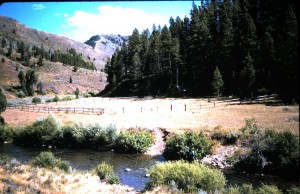Bear Creek
Bear Creek
In his writings Ernie Schwiebert devotes quality efforts to “The Song of the Small Stream.” He did so for good reason. In so many ways small streams offer an escape from the demands that larger waters place on us for fishing success. Small streams are certainly more easily approached. They lack the physical perils of large rivers. Their smaller scope results in an ease in determining where fish may reside at a certain time. And resident fish mostly seem less selective here than in the larger waters. Who among us does not savor the experiences large rivers offer? But this makes them more visited, and therein lies another asset to smaller waters; a better chance for solitude.
The Greater Yellowstone area abounds in high quality small streams. So where does one start to discuss these? We begin with Bear Creek, a tributary to Palisades Reservoir on the Snake River and straddling the Idaho-Wyoming border. Because of an essentially Yellowstone cutthroat trout only population, it is a rarity among streams. Thus catch and release fishing applies. It flows into the aptly named Bear Creek Arm on the southwest side of the reservoir. From eastern Idaho’s Snake River Plain, one travels east on US Highway 26 to just below Palisades Dam, crosses the South Fork reach of the Snake River here, then follows the USFS signs eight miles to the Bear Creek estuary. With spectacular scenery it’s a beautiful eight miles, certainly worthy of a high resolution camera. At the estuary a former campground serves as an ample parking area with the Bear Creek trail head at the upstream end. From here the trail parallels the creek for several miles. The creek remains mostly in view along the trail. It’s a freestone stream of moderate gradient but with slower portions and abundant deeper holes and runs. During springtime this creek is a significant spawning stream for Yellowstone cutthroat trout. In good water years many of these fish remain in the creek’s quality water, perhaps into September. These fish range to good sizes with a few specimens exceeding twenty inches. But mostly this stream rears fish which eventually head for the reservoir below. Look for the larger fish to reside in the abundant deeper holes and runs. Be particularly aware of deeper water sheltered by overhanging willow and grasses. Such will shelter foraging individuals. So do the newer beaver ponds located mainly above the Current Creek Guard Station, a holdover from days when forest rangers patrolled the area on fire watch, to monitor wildlife situations, and livestock impacts. The station is nearly two miles upstream from the trail head, and is a good photography subject. See it situated in shadows on the other side of the creek in the above photo. On the opposite side of the creek is potable spring water piped to serve guard station occupants.
The scene in the picture above is mid summer when Bear Creek is at its most interesting fishing. Judicious wet wading is appropriate, but no more than hip waders are necessary. A few PMDs will come to the surface in afternoons during this time. Later in the day abundant caddis appear. But the most enjoyable way to encounter resident cutthroat is through presenting terrestrial insect patterns. Keep the sun to your back as much as possible when on the stream. Drift your patterns beneath overhangs above water of sheltering depth. Test the top ends of deeper holes and banks and inlets of the beaver ponds. Soft hackle flies make good presentation alternatives when aquatic insects emerge. So do a variety of nymph patterns (size 10-18), with and without a bead. A three or four weight set-up with a floating line is ideal for presenting flies here, and a long fine leader (4x-5x) is a must because of the ultra clear water. A good strategy is to begin fishing around mid day when water temperatures arrive at levels suitable for insect activity. Continue fishing to around six in the evening. The walk out will add to one’s appetite for an excellent dinner many of which are offered in restaurants and fishing lodges along Highway 26.

